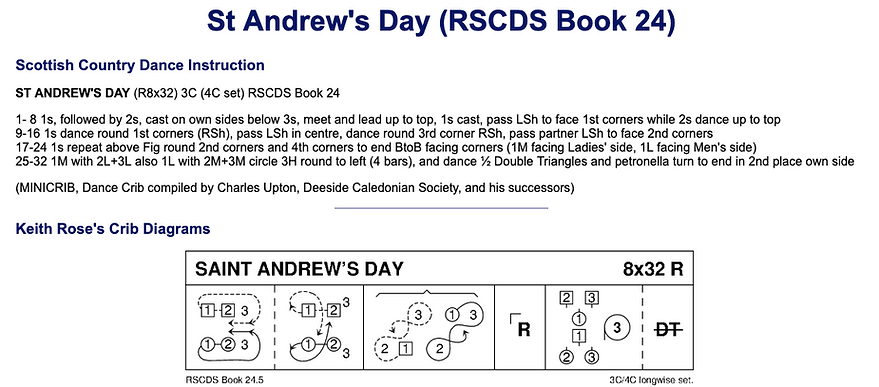




WELCOME TO An Entertainment Site for Scottish Country Dancers - Enjoy the curated selection of theme-related dances for celebrations and holidays, or find a dance associated with a special calendar day, or EVEN your own birthday!
St. Andrew's Day
Nov 30
Other Scottish Country Dances for this Day
Today's Musings, History & Folklore
Happy St. Andrew's Day!
Althought some of the many namesake dances for St. Andrew's Day are 128 bar performance pieces, this 32 bar version with its saltire-shaped reels from opposite corners will do nicely for an easier to learn and celebratory jig! complex Legend has it that in 832 AD, King Angus led an army of Picts and Scots into the Lothians, then part of Northumbrian territory. Surrounded by Saxons and on the brink of defeat, the king turned to prayer. Miraculously, a cloud formed in the shape of a white Saltire against the blue sky, a sign that Angus took as divine intervention. Inspired by this vision and appealing to St. Andrew for aid, his army rallied and triumphed in battle. In gratitude, King Angus declared St. Andrew the patron saint of Scotland. However, it wasn’t until 1320, with the signing of the Declaration of Arbroath asserting Scotland’s independence, that St. Andrew was officially recognized as the nation's patron saint. "Alba Gu Bràth!" 💙 🤍 💙 🏴
St Andrew's Day
Happy Saint Andrew's Day!
In Scotland, and many countries with Scottish connections, St. Andrew's Day is marked with a celebration of Scottish culture with traditional Scottish food, music and dance. In Scotland, the day is also seen as the start of the winter festivals, encompassing St Andrew's Day, Hogmanay and Burns Night.
St. Andrew's Night (the eve before November 30th) was considered in many parts of Eastern Europe a magical night that could be used to divine information about a young woman's marriage prospects. Young women might light a candle saved from Easter and bring it, at midnight, to a fountain. They would ask St. Andrew to let them glimpse their future husband in the water's reflection.
Related customs exist, such as the pouring of hot lead or wax into water, divining the future husband's profession from the shape of the resulting piece.
On this night, St Andrew would also invoked to ward off wolves, who are thought to be able to eat any animal they want on this night as well has possess the temporary ability to speak to humans, though this will bring grave misfortune.
The Flag of Scotland shown above, (Scottish Gaelic: Bratach na h-Alba), also known as St Andrew's Cross or the Saltire, is the national flag of Scotland.
For more St. Andrew's Night traditions, click the painting by Henryk Siemiradzki, St. Andrew’s Night - Fortune-Teller, 1867.
Click the dance cribs or description below to link to a printable version of the dance!





